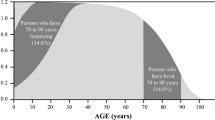Abstract
Although convergence to stability is typically a complex and irregular process, the Kullback distance provides a measure that moves consistently to 0 as a population becomes stable. The roots of the Kullback distance are in information theory. but it is a meaningful demographic quantity. It reflects a population’s log momentum, or the amount of growth built into a population’s nonstable age distribution. The rate at which the Kullback distance moves toward 0 is neither constant nor monotonic. At any point in time, however, it decreases by the covariance between a population’s age-specific growth rates and its log momentum. Although the present findings are couched in terms of movement toward stability, they are generally applicable because they relate to the behavior of any population at any instant. It is a fundamental principle of population dynamics that a population is always moving toward the stable population implied by its prevailing fertility and mortality rates, and that the extent of its movement is determined by the covariance between its age-specific growth and its log momentum.
Similar content being viewed by others
References
Cohen, Joel E. 1979. “The Cumulative Distance from an Observed to a Stable Age Structure.” SIAM Journal of Applied Mathematics 36:169–75.
Demetrius, L. 1979. “Relations between Demographic Parameters.” Demography 16:329–38.
Freeman, H. 1960. Finite Differences for Actuarial Students. Cambridge: Cambridge UniversityPress.
Golubitsky, M., E.B. Keeler, and M. Rothschild. 1975. “Convergence of the Age Structure: Applications of the Projective Metric.” Theoretical Population Biology 7:84–93.
Keyfitz, Nathan. 1971. “On the Momentum of Population Growth.” Demography 8:71–80.
—. 1977. Introduction to the Mathematics of Population (Revised ed.) Reading, MA: Addison-Wesley.
—. 1985. Applied Mathematical Demography (2nd ed.) New York: Springer-Verlag.
Keyfitz, Nathan and Wilhelm Flieger. 1968. World Population: An Analysis of Vital Data. Chicago: University of Chicago Press.
Preston, Samuel H. 1986. “The Relation between Actual and Intrinsic Growth Rates.” Population Studies 40:343–51.
Preston, Samuel H. and Ansley J. Coale. 1982. “Age Structure, Growth, Attrition, and Accession:A New Synthesis.” Population Index 48:217–59.
Preston, S.H., C. Himes, and M. Eggers. 1989. “Demographic Conditions Responsible for Population Aging.” Demography 26:691–04.
Schlögl, F. 1976. “Mixing Distance and Stability of Steady States in Statistical Nonlinear Thermodynamics.” Zeitschrift für Physik B 25:411–21.
Tuljapurkar, S.D. 1982. “Why use Population Entropy? It Determines the Rate of Convergence.” Journal of Mathematical Biology 13:325–37.
Author information
Authors and Affiliations
Additional information
This research was supported in part by Grant ROI HD19145 from the National Institute for Child Health and Human Development.
Rights and permissions
About this article
Cite this article
Schoen, R., Kim, Y.J. Movement toward stability as a fundamental principle of population dynamics. Demography 28, 455–466 (1991). https://doi.org/10.2307/2061467
Issue Date:
DOI: https://doi.org/10.2307/2061467




